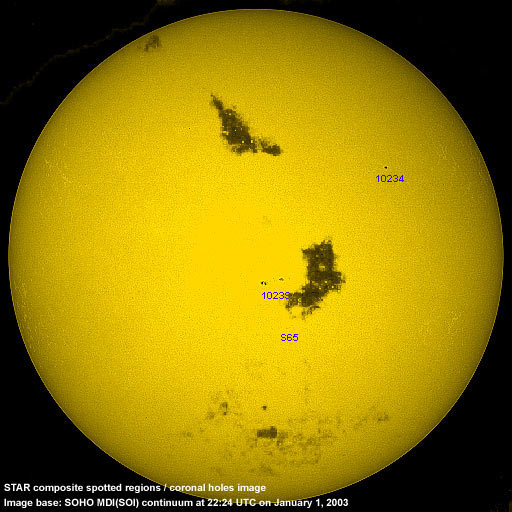

Last update January 2, 2003 at 04:15 UTC. Minor update posted at 23:30 UTC (sunspot data added)
[Solar and geomagnetic data
- last 4 weeks (updated daily)]
[Solar wind and electron
fluence charts (updated daily)]
[Solar cycles 21-23 (last
update January 1, 2003)]
[Solar cycles 1-20]
[Graphical comparison of
cycles 21, 22 and 23 (last update January 1, 2003)]
[Graphical comparison of
cycles 10, 13, 17, 20 and 23 (last update January 1, 2003)]
[Historical solar and geomagnetic
data charts 1954-2002 (last update October 13, 2002)]
[Archived reports (last update January 1, 2003)]
The geomagnetic field was quiet to unsettled on January 1. Solar wind speed ranged between 358 and 447 km/sec.
Solar flux measured at 20h UTC on 2.8 GHz was 115.0. The planetary A
index was 10 (STAR Ap - based on the mean of three hour interval ap indices: 11.4).
Three hour interval K indices: 22333322 (planetary), 22322222 (Boulder).
The background x-ray flux is at the class B1-B2 level.
At midnight there were 3 spotted regions on the visible disk. Solar flare activity was very low.
Region 10234 was mostly quiet and stable.
Region 10239 developed slowly and quietly.
Spotted regions not yet numbered by SEC:
[S65] A new region emerged late on January 1 to the southwest of region 10239. Location at midnight: S16W07.
December 30-January 1: No obviously geoeffective CMEs observed. A CME was observed starting in LASCO C2 images at 22:06 UTC on December 31 off of the southeast limb. As there was no activity on the visible disk at the time, this CME highly likely had a backside origin.
Coronal hole history (since late October 2002)
Compare today's report with the situation one solar rotation ago: 28
days ago
27 days ago 26 days ago
A recurrent trans equatorial coronal hole was in a geoeffective position on December 31-January 1.

Processed SOHO EIT 284 image at 19:06 UTC on January 1. Any black areas on the solar disk are likely coronal holes.
The geomagnetic field is expected to be quiet to unsettled on January 2. A coronal stream will likely arrive on January 3 and cause unsettled to minor storm conditions. Long distance medium wave (AM) band propagation along east-west paths over high and upper middle latitudes is fair.
| Coronal holes (1) | Coronal mass ejections (2) | M and X class flares (3) |
1) Effects from a coronal hole could reach Earth within the
next 5 days.
2) Material from a CME is likely to impact Earth within 96 hours.
3) There is a possibility of either M or X class flares within the next 48
hours.
Green: 0-20% probability, Yellow: 20-60% probability, Red: 60-100% probability.

Composite image based on a SOHO/MDI continuum image and overlaid by a coronal hole image and a processed white light image. Region numbering has been included. Compare to the previous day's image.
Data for all numbered solar regions according to the Solar Region Summary provided by SEC/NOAA. Comments are my own, as is the STAR spot count (spots observed at or inside a few hours before midnight) and data for regions not numbered by SEC or where SEC has observed no spots.
| Solar region | Date numbered | SEC spot count |
STAR spot count |
Location at midnight | Area | Classification | Comment |
|---|---|---|---|---|---|---|---|
| 10233 | 2002.12.23 | N13W77 | plage | ||||
| 10234 | 2002.12.24 | 3 | 1 | N19W33 | 0030 | HSX | |
| 10235 | 2002.12.25 | N14W61 | plage | ||||
| 10237 | 2002.12.28 | S26W52 | plage | ||||
| 10238 | 2002.12.28 | N09W37 | plage | ||||
| 10239 | 2002.12.29 | 11 | 10 | S09W04 | 0080 | DAI | |
| 10240 | 2002.12.30 | 3 | S08E06 | 0010 | BXO | now spotless | |
| S63 | emerged on 2002.12.29 |
S15W54 | plage | ||||
| S65 | emerged on 2003.01.01 |
2 | S16W07 | 0020 | CSO | ||
| Total spot count: | 17 | 13 | |||||
| SSN: | 47 | 43 | |||||
| Month | Average solar flux at Earth |
International sunspot number | Smoothed sunspot number |
|---|---|---|---|
| 2000.04 | 184.2 | 125.5 | 120.8 cycle 23 sunspot max. |
| 2000.07 | 202.3 | 170.1 | 119.8 |
| 2001.12 | 235.1 | 132.2 | 114.6 (-0.9) |
| 2002.01 | 226.6 | 114.1 | 113.5 (-1.1) |
| 2002.02 | 205.0 | 107.4 | 114.6 (+1.2) |
| 2002.03 | 179.5 | 98.4 | 113.3 (-1.3) |
| 2002.04 | 189.8 | 120.7 | 110.5 (-2.9) |
| 2002.05 | 178.4 | 120.8 | 108.8 (-1.7) |
| 2002.06 | 148.7 | 88.3 | 106.2 (-2.6) |
| 2002.07 | 173.5 | 99.6 | (102.1 predicted, -4.1) |
| 2002.08 | 183.6 | 116.4 | (98.5 predicted, -3.6) |
| 2002.09 | 175.8 | 109.6 | (95.5 predicted, -3.0) |
| 2002.10 | 167.0 | 97.5 | (92.0 predicted, -3.5) |
| 2002.11 | 168.7 | 95.0 | (86.7 predicted, -5.3) |
| 2002.12 | 157.2 | 81.6 | (82.4 predicted, -4.3) |
| 2003.01 | 115.0 (1) | 1.5 (2) | (79.4 predicted, -3.0) |
1) Running average based on the daily 20:00 UT observed solar flux value at 2800
MHz.
2) Unofficial, accumulated value based on the Boulder (SEC/NOAA) sunspot number. The official
international sunspot number is typically 25-45% less.
This report has been prepared by Jan Alvestad. It is based partly on my own observations and interpretations, and partly on data from sources noted in solar links. Comments and suggestions are always welcome.
| [DX-Listeners' Club] |